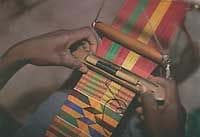Kente is an Asante ceremonial cloth hand-woven on a horizontal treadle loom. Strips measuring about 4 inches wide are sewn together into larger pieces of cloths. Cloths come in various colors, sizes and designs and are worn during very important social and religious occasions. In a total cultural context, kente is more important than just a cloth.
It is a visual representation of history, philosophy, ethics, oral literature, moral values, social code of conduct, religious beliefs, political thought and aesthetic principles.
Although Kente, as we know it was developed in the 17th Century A.D. by the Ashanti people, it has it roots in a long tradition of weaving in Africa dating back to about 3000 B.C. The origin of Kente is explained with both a legend and historical accounts. A legend has it that a man named Ota Karaban and his friend Kwaku Ameyaw from the town of Bonwire (now the leading Kente weaving center in Ashanti), learned the art of weaving by observing a spider weaving its web. Taking a cue from the spider, they wove a strip of raffia fabric and later improved upon their skill. They reported their discovery to their chief Nana Bobie, who in turn reported it to the Asantehene (The Ashanti Chief) at that time. The Asantehene adopted it as a royal cloth and encouraged its development as a cloth of prestige reserved for special occasions.
Historical accounts trace the origin of Kente weaving to early weaving traditions in ancient West African Kingdoms that flourished between 300 A.D. and 1600 A.D. Some historians maintain that Kente is an outgrowth of various weaving traditions that existed in West Africa prior to the formation of the Ashanti Kingdom in the 17th Century. Archaeological research has dated examples of narrow-strip cloths woven in West Africa as early as the 11th Century A.D. and perhaps earlier. Some examples of woven fabrics have been found in the caves of the Bandiagara cliffs in Mali. These cloths used in burial ceremonies, probably, during the medieval Ghana, Mali and Soghai Empires, have technical and aesthetic features similar to many of the narrow-strip cloths in many parts of West Africa. Such cloths which the Akans call "Nsaa" are important components of scared royal paraphernalia in most Akan royal courts today and are know to have been traded with articles of prestige by Akan Kings and chiefs early in the 17th Century. Many features of such cloths appear in the early and later narrow-strip cloths woven in Ashanti. Given these historical accounts, it is believed that the Ashanti craftsmen might have learned weaving skills from other peoples living North and West of them and later developed their unique style of cloth.
While Kente Cloth may have its roots in 11th Century West African weaving traditions, weaving in Africa as a whole was developed earlier. Elsewhere in Africa, archaeological excavations have produced such weaving instruments as spindle whores and loom weights in ancient Meroe Empire which flourished between 500 B.C. and 300 A.D. in other African Civilizations in the Nile Valley such as Kemte (Egypt) and Nubia or Kush, there is an abundance of pictorial and archaeological evidence proving the existence of a weaving industry as early as 3200 B.C.
The term kente has its roots in the word kenten which means "basket". The first kente weavers used raffia fibers to weave cloths that looked like kenten and thus were referred to as kenten ntoma; meaning "basket cloth".
The original Asante name of the cloth was nsaduaso or nwontoma meaning "a cloth hand-woven on a loom" and is still used today by Asante weavers and elders. However, the term kente is the most popularly used today, in and outside Ghana. Many variations of narrow-strip cloths, similar to kente are woven by various ethnic groups in Ghana and elsewhere in Africa.
Traditionally, kente is mainly woven by the Asante and the Ewe tribes of Ghana. The Asante kente is woven in villages just outside Kumasi in the area around Bonwire and Ntonso. Kente is also woven b
Source:
Please rate this
Poor




 Excellent
Excellent




 Excellent
Excellent
Votes: 0 |NaN out of 5







